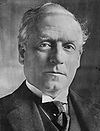Harold Tennant
Harold Tennant | |
|---|---|
 Photo c. 1910s | |
| Secretary for Scotland | |
| In office 9 July 1916 – 5 December 1916 | |
| Monarch | George V |
| Prime Minister | H. H. Asquith |
| Preceded by | Thomas McKinnon Wood |
| Succeeded by | Robert Munro |
| Personal details | |
| Born | 18 November 1865 The Glen, Innerleithen, Peeblesshire, Scotland |
| Died | 9 December 1935 (aged 69) |
| Political party | Liberal |
| Spouse | |
| Parent(s) | Sir Charles Tennant, 1st Baronet Emma Winsloe |
| Alma mater | Trinity College, Cambridge |
Harold John Tennant PC (18 November 1865 – 9 November 1935), often known as Jack Tennant, was a Scottish Liberal politician. He served as Secretary for Scotland under his brother-in-law H. H. Asquith between July and December 1916.
Background and education
[edit]Born at The Glen, Innerleithen, Peeblesshire,[1] Harold Tennant was a younger son of Sir Charles Tennant, 1st Baronet, by his first wife Emma, daughter of Richard Winsloe. He was the brother of Edward Tennant, 1st Baron Glenconner and Margot Asquith (and hence the brother-in-law of H. H. Asquith) and the half-brother of Baroness Elliot of Harwood.
Tennant was educated at Eton College and at Trinity College, Cambridge.[2]
Political career
[edit]
Tennant was Assistant Private Secretary to his brother-in-law H. H. Asquith while the latter was Home Secretary between 1892 and 1895.[3] In 1894 he was elected Member of Parliament for Berwickshire.[4] Asquith became Prime Minister in 1908 and in January 1909 he appointed Tennant Parliamentary Secretary to the Board of Trade. Tennant remained in this office until 1911, and then served under Asquith as Financial Secretary to the War Office from 1911 to 1912 and as Under-Secretary of State for War from 1912 to 1916. In 1914 he was sworn of the Privy Council.[5] He entered the cabinet as Secretary for Scotland under Asquith in July 1916,[6] a post he held until Asquith was ousted as Prime Minister in December 1916. Tennant did not serve under David Lloyd George.
At the 1918 general election, the Berwickshire constituency was abolished, and Tennant contested the new Berwickshire and Haddingtonshire constituency. He faced two opponents: R. W. Foulis of the Labour Party, and the 1911–1918 Haddingtonshire MP John Deans Hope. With two incumbent Liberal MPs contesting one seat, Hope's receipt of the coalition coupon secured his victory, with 54% of the votes. Tennant came a poor third, with only 16% of the votes.[7]
Tennant also unsuccessfully contested Glasgow Central in 1923[8] but never returned to the House of Commons.
During his time in Parliament, Tennant supported a number of progressive measures such as worker's compensation,[9] minimum wage provisions,[10] school medical inspections,[11] factory inspections, and unemployment insurance.
Personal life
[edit]
Tennant married factory inspector May Abraham in 1896. He bought Great Maytham Hall, Rolvenden, Kent, in 1910. He commissioned Edwin Lutyens to rebuild the hall at a cost of £24,000.[12] As leader of the war memorial committee, he also engaged Lutyens to design the Rolvenden War Memorial, erected in 1922.[13]
Tennant died in November 1935, aged 70.
References
[edit]- ^ Curthoys, M. C. (2009). "Tennant, Harold John [Jack] (1865-1935), politician". Oxford Dictionary of National Biography (online ed.). Oxford University Press. doi:10.1093/ref:odnb/58263. Retrieved 27 January 2019. (Subscription or UK public library membership required.)
- ^ "Tennant, Harold John (TNNT885HJ)". A Cambridge Alumni Database. University of Cambridge.
- ^ Betts, Robin (1999). Doctor Macnamara, 1861-1931. Liverpool University Press. p. 385 (endnote). ISBN 0853238634. Retrieved 29 June 2015.
- ^ "leighrayment.com Bedford to Berwick upon Tweed". Archived from the original on 24 February 2012. Retrieved 30 September 2009.
{{cite web}}: CS1 maint: unfit URL (link) - ^ leighrayment.com Privy Counsellors 1836-1914[usurped]
- ^ "No. 29667". The London Gazette. 14 July 1916. p. 6975.
- ^ Craig, F. W. S. (1983) [1969]. British parliamentary election results 1918–1949 (3rd ed.). Chichester: Parliamentary Research Services. p. 629. ISBN 0-900178-06-X.
- ^ The Times, 8 December 1923
- ^ "Workmens Compensation Bill 1 (1906)". Parliamentary Debates (Hansard). House of Commons. 26 March 1906. Retrieved 28 April 2020.
- ^ "Trade Boards Bill (1909)". Parliamentary Debates (Hansard). House of Commons. 28 April 1909. Retrieved 28 April 2020.
- ^ "Medical Inspection of Children (1908)". Parliamentary Debates (Hansard). House of Commons. 6 July 1908. Retrieved 28 April 2020.
- ^ Tyzack, Anna (1 July 2009). "The Secret Garden for sale". The Daily Telegraph. London. Archived from the original on 19 August 2009. Retrieved 23 November 2010.
- ^ Historic England. "Rolvenden War Memorial (1381140)". National Heritage List for England. Retrieved 11 September 2016.
- Torrance, David, The Scottish Secretaries (Birlinn 2006)
External links
[edit]- 1865 births
- 1935 deaths
- People educated at Eton College
- Alumni of Trinity College, Cambridge
- Scottish Liberal Party MPs
- Members of the Privy Council of the United Kingdom
- Members of the Parliament of the United Kingdom for Scottish constituencies
- Tennant family
- UK MPs 1892–1895
- UK MPs 1895–1900
- UK MPs 1900–1906
- UK MPs 1906–1910
- UK MPs 1910
- UK MPs 1910–1918
- Younger sons of baronets
- People from Rolvenden
- Deputy lieutenants of Aberdeen
- Parliamentary Secretaries to the Board of Trade
- Secretaries for Scotland


